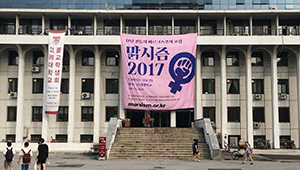UniHallers Korean Exchange Program
22 November 2017
During the semester breaks, University Hall (UniHall) residents are off on vacations, road trips and exchange programs all around the globe.
UniHall Reporter Hazel Tan is traveled on a four-week exchange program to Korea University and has written about on her experience in Seoul, South Korea.
Media consumption in Seoul was one of the first topics she delved into. Out of 19 million households in Korea, a mind-blowing 99.2% have access to the Internet. There has been a decline in PC usage due to everything going mobile (not exclusively in Korea) – shopping, navigation maps, banking, food delivery and social media sites. Korea is a country that has become multicultural but has not embraced multiculturalism, which can be seen from the Korean language being the dominating language used in the country. For instance, Google Maps does not function in Korea due to map data transfer regulations. Even so, many of the buildings and streets named in Korean. Naver is a mobile application that is used in its stead, and it has many functions ranging from a search bar (in replacement of Google) and its own map, Naver Maps. It is very challenging for someone who is not fluent in the Korean language to utilise the application, which has little pictures for guidance. I attempted to use the Yogiyo application to order food delivery, which is very popular in Korean television shows, but due to the language barrier I had to ask my AirBNB host for help.
Despite the rampant use and consumption of digital media in Seoul, there are still many traditional forms of media in the daily lives of Korean people. From newspaper stands to big-screen ads in the subway station, Korea still resorts to many mediums of traditional media. At home, there are many commercials shown during breaks between television shows and some television channels function solely as a shopping catalogue to promote the purchase of products. In Korea University, students hang up huge banners (of course, written or printed in Korean) across the building about important notices. The image to accompany this story is just one of the banners, this one is hung over the Korea University. They have many stacks of printed newsletters and magazines in baskets for students to take, browse and keep for themselves.
There was only time to capture a small part of the exchange but Hazel was also able to experience Korean culture, such as the Hallyu wave, traditional culture and their food culture! This was an opportunity she will always remember in her UWA studies.
